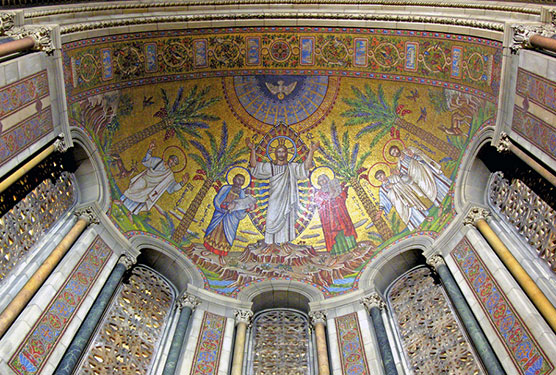
Apse Transfiguration, St. Bartholomew's Church,1929, mosaics
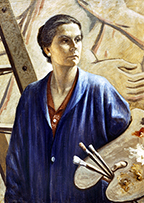
Self-Portrait, 1943
Bertram Goodhue often talked of the designing triumvirate, a collaboration of architect, sculptor and painter as free and equal designers. Central to the aesthetic power and social messages implicit in Goodhue's best work are the contributions of his artistic collaborators, notably architectural sculptor Lee Lawrie, and muralist Hildreth Meière, whose works are defining features of St. Bartholomew’s.
A distinguished decorative artist of the Art Deco era, Hildreth Meière (1892 – 1961) ranks among the very small number of women whose achievements gained the recognition of the established art world during the first half of the 20th century. She worked in a wide variety of mediums, such as paint, terra cotta, and ceramic tile, but one of her favorites was mosaic.
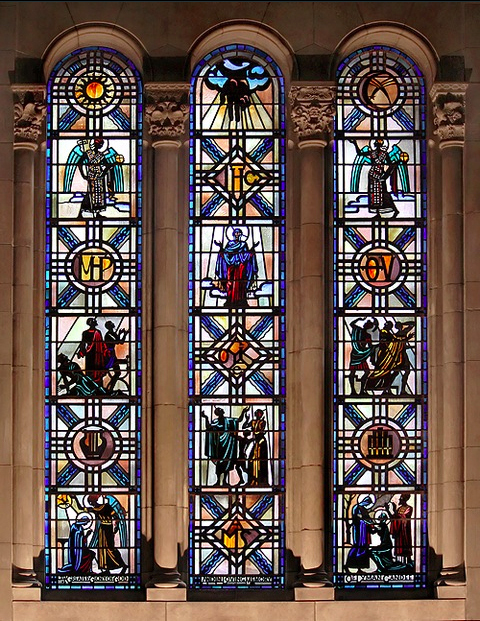
Clerestory Window, St. Bartholomew's Church, with Benedicite in stained glass, 1956;
photo: Hildreth Meière Dunn
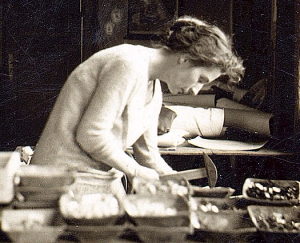
Hildreth Meière learning the mosaic-making-process at the Pühl & Wagner factory, Berlin, 1928
Meière was commissioned in 1929 to design glass mosaics for the narthex and the apse at St. Bartholomew's Church. The mosaics were fabricated from colored and gold-leafed glass tiles. The shades of gold in these works number in the hundreds. The subject of the mosaic In the half dome of the apse is the Transfiguration, with Christ flanked by Elijah and Moses and accompanied by Peter, James and John. Meière also designed eight mosaic panels depicting symbols of Christ, such as the phoenix and the pelican, that were set into the marble stringcourse below the chancel windows. For her designs in the narthex, Meière provided an Art Deco interpretation of the Christian creation cycle, drawing on the fifth-century Mausoleum of Galla Placidia in Ravenna, Italy. Between 1948 and 1956, Meière also designed stained glass windows for the nave of St. Bartholomew’s. Three sets of three windows – the Magnificat, Gloria in Excelsis Deo, and Nunc Dimittus, were installed in the south clerestory and her Benedicite window is one of three sets occupying the north clerestory.For more on Hildreth Meière, please visit the International Meière Association.
Lee Lawrie
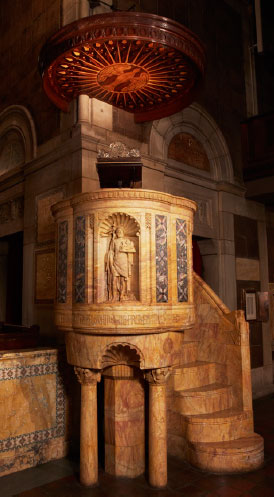
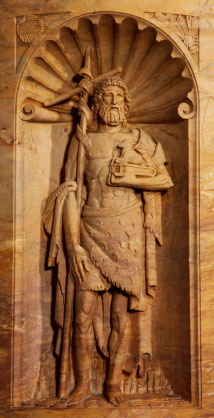
Pulpit, St. Bartholomew's Church, 1925, detail on right; photo: James Salzano
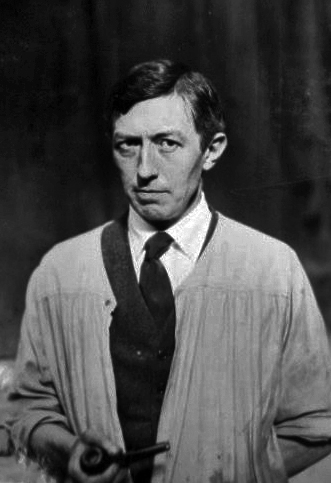
Lee Oscar Lawrie (1877 – 1963) was one of the United States' foremost architectural sculptors and a key figure in the American art scene preceding World War II. Over his long career of more than 300 commissions, Lawrie's style evolved through Modern Gothic, to Beaux-Arts Classicism and finally into Moderne or Art Deco. He began working with Goodhue in 1895, his specialization in architectural sculpture complemented Goodhue’s early Gothic revival designs.
Many of his architectural sculptures can be found in the chapel at West Point; the National Academy of Sciences in Washington, D.C.; the Nebraska State Capitol; the Los Angeles Public Library; St. Bartholomew's Episcopal Church in New York; and Rockefeller Chapel at the University of Chicago. He completed numerous pieces in Washington, D.C., including the bronze doors of the John Adams Building of the Library of Congress, the Basilica of the National Shrine of the Immaculate Conception south entrance portal, and the interior sculpture of George Washington at the National Cathedral.
Artists / Artisans
Daniel Chester French (Triple Portal); Andrew O’Connor (Center Bronze Door, Lintel, Tympanum, Great Frieze); Philip Martiny (South Bronze Door, Lintel, Tympanum, Four Old Testament Statues); Herbert Adams (North Bronze Door, Lintel and Tympanum); Lee Lawrie (Pulpit, Lectern, Altar, Altar Rail); Hildreth Meière (Mosaics, Stained Glass); Allyn Cox (Stained Glass); John Gordon Guthrie (Stained Glass); Henry Wynd Young (Stained Glass); Victorio Ciani (Baptistry Reredos); James Redfern (Baptistry Font); Frances & Rohnstock Reynolds (Stained Glass); Ethel Parsons Paullin (Chapel Painting); Telford Paullin (Chapel Mural); Francis Augustus Lathrop (Painting); Piccirilli Brothers (Carving Throughout Church); and the Aeolian-Skinner Organ Company.

